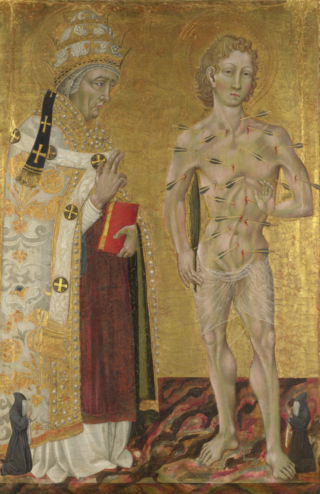
Pope Fabian was the bishop of Rome from 10 January 236 until his death on 20 January 250, succeeding Anterus. A dove is said to have descended on his head to mark him as the Holy Spirit's unexpected choice to become the next pope. He was succeeded by Cornelius.
Pope Caius, also called Gaius, was the bishop of Rome from 17 December 283 to his death in 296. Little information on Caius is available except that given by the Liber Pontificalis, which relies on a legendary account of the martyrdom of Susanna of Rome for its information. According to legend, Caius baptized the men and women who had been converted by Tiburtius and Castulus. His legend states that Caius took refuge in the catacombs of Rome and died a martyr.
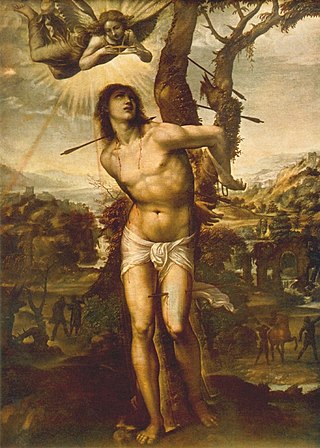
Sebastian was an early Christian saint and martyr. According to traditional belief, he was killed during the Diocletianic Persecution of Christians. He was initially tied to a post or tree and shot with arrows, though this did not kill him. He was, according to tradition, rescued and healed by Irene of Rome, which became a popular subject in 17th-century painting. In all versions of the story, shortly after his recovery he went to Diocletian to warn him about his sins, and as a result was clubbed to death. He is venerated in the Catholic Church and the Orthodox Church.
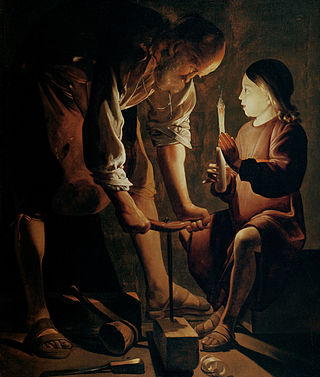
Georges de La Tour was a French Baroque painter, who spent most of his working life in the Duchy of Lorraine, which was temporarily absorbed into France between 1641 and 1648. He painted mostly religious chiaroscuro scenes lit by candlelight.

Saint Nino was a woman who preached Christianity in the territory of the Kingdom of Iberia, in what is modern-day Georgia. Her preaching resulted in the Christianization of Iberia.

In Catholic tradition, the Five Holy Wounds, also known as the Five Sacred Wounds or the Five Precious Wounds, are the five piercing wounds that Jesus Christ suffered during his crucifixion. The wounds have been the focus of particular devotions, especially in the late Middle Ages, and have often been reflected in church music and art.
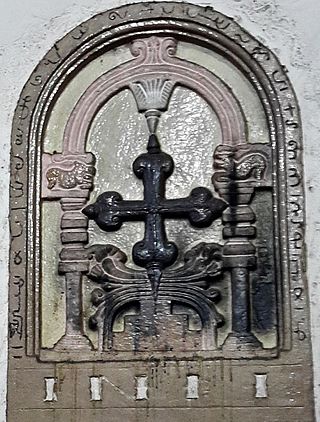
The Synod of Diamper (Udayamperoor Synod) (Malayalam: ഉദയംപേരൂർ സൂനഹദോസ്, romanized: Udayampērūṟ Sūnahadōs), held at Udayamperoor (known as Diamper in non-vernacular sources) in June 1599, was a diocesan synod, or council, that created rules and regulations for the ancient Saint Thomas Christians (also known as Mar Thoma Nasranis) of the Malabar Coast, a part of modern-day Kerala state, India, formally subjugating them and downgrading their whole Metropolitanate of India as the Diocese of Angamale, a suffragan see to the Archdiocese of Goa administered by Latin Church Padroado missionaries. This synod also introduced forced Liturgical Latinisation and the eschewal of local practices and beliefs, leading to a significant ecclesial protest by Saint Thomas Christians known as Coonan Cross Oath and a subsequent schism in the mid-17th century.

As the home of the Pope and the Catholic curia, as well as the locus of many sites and relics of veneration related to apostles, saints and Christian martyrs, Rome had long been a destination for pilgrims. The Via Francigena was an ancient pilgrim route between England and Rome. It was customary to end the pilgrimage with a visit to the tombs of Saints Peter and Paul. Periodically, some were moved to travel to Rome for the spiritual benefits accrued during a Jubilee. These indulgences sometimes required a visit to a specific church or churches. Pilgrims need not visit each church.

The Four Crowned Martyrs or Four Holy Crowned Ones were nine individuals who are venerated as martyrs and saints of Early Christianity. The nine saints are divided into two groups:
- Severus, Severian(us), Carpophorus (Carpoforus), Victorinus
- Claudius, Castorius, Symphorian (Simpronian), Nicostratus, and Simplicius

Mark and Marcellian are martyrs venerated as saints by the Roman Catholic Church and the Eastern Orthodox Church. Their cult is sometimes associated with that of Saints Tranquillinus, Martia, Nicostratus, Zoe, Castulus, and Tiburtius, though not in the official liturgical books of the Church, which mention only Mark and Marcellianus among the saints for 18 June. Their mention in the General Roman Calendar on that date from before the time of the Tridentine calendar was removed in the 1969 revision, because nothing is known about them except their names, the fact of their martyrdom, and that they were buried on 18 June in the cemetery of Santa Balbina on the Via Ardeatina.

Fabiola or, the Church of the Catacombs is a novel by the English Cardinal Nicholas Wiseman. It was first published in 1854. The novel has been adapted to film three times.
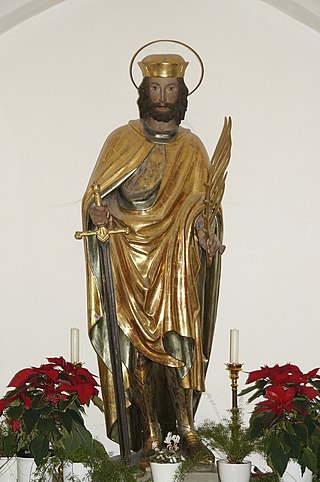
Castulus is venerated as a martyr and saint. According to tradition, he was the chamberlain of Emperor Diocletian and the husband of Irene of Rome.

Trophime Bigot (1579–1650), also known as Théophile Bigot, Teofili Trufemondi, the Candlelight Master, was a French painter of the Baroque era, active in Rome and his native Provence.

Magdalene with the Smoking Flame is a c. 1640 oil-on-canvas depiction of Mary Magdalene by French Baroque painter Georges de La Tour. Two versions of this painting exist, one in the Los Angeles County Museum of Art and the other in the Louvre Museum.

Saint Sebastian Tended by Irene is an oil-on-canvas painting by Hendrick ter Brugghen dated to 1625. Now in the Allen Memorial Art Museum of Oberlin, Ohio, the piece depicts the Roman Catholic subject of Saint Sebastian Tended by Saint Irene, after Irene of Rome and her maid rescued him following his attempted martyrdom by the Roman authorities. An exemplary piece of the Italianate Baroque tendency in Dutch Golden Age painting, the painting employs dramatic uses of light and skillful chiaroscuro to depict its religious subject, evidence of influence from Caravaggio and Ter Brugghen's fellow Utrecht Caravaggisti.

Saint Sebastian Tended by Saint Irene is a c.1649 oil-on-canvas painting by Georges de La Tour. It is one of the largest known paintings by the artist and his most ambitious composition. It was rediscovered in 1945 in the parish church of Bois-Anzeray and acquired by the Société des amis du Louvre for the Louvre in 1979 as inventory number R.F. 1979–53.
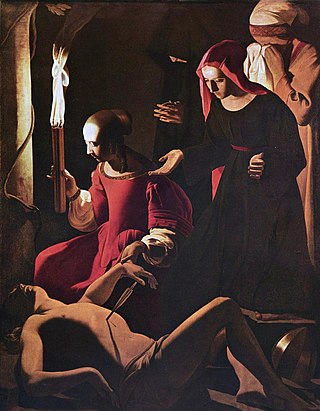
Saint Sebastian Tended by Saint Irene is a c. 1634–1643 oil-on-canvas painting of Saint Sebastian having his wounds tended by Saint Irene, which suddenly became a popular subject in the 1620s. It is now in the Gemäldegalerie, Berlin.
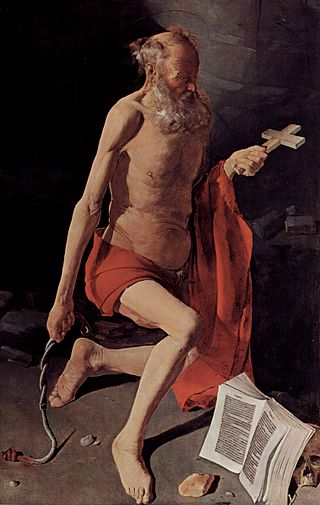
St Jerome at Prayer is an oil-on-canvas painting executed ca. 1630–1635 by the French artist Georges de La Tour. He produced it for the abbey of Saint Antoine a Viennois, but it was confiscated by the state on the French Revolution and is now in the Museum of Grenoble. An autograph copy with some variations was produced sometime before 1642 and is now in the Nationalmuseum in Stockholm.
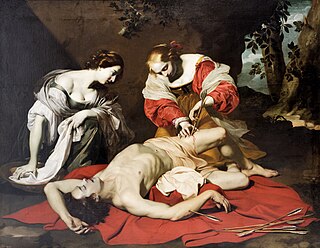
Saint Sebastian Tended by Saint Irene is an incident in the legends of Saint Sebastian and Saint Irene of Rome. It was not prominent in the hagiographical literature until the late Renaissance, and is hardly seen in art before then. As an artistic subject, normally in painting, it suddenly became popular from the 1610s, though found in predella scenes as early as the 15th century, and was most popular until about the 1670s.
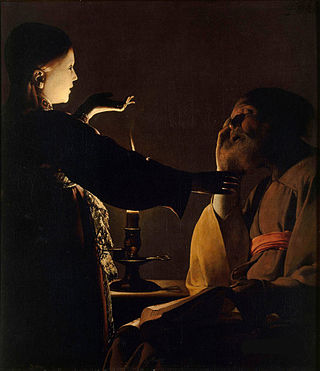
The Dream of Saint Joseph is an oil-on-canvas painting created between 1628 and 1645 by the French Baroque painter Georges de La Tour which is now in the collection of the Musée d'Arts de Nantes.



























